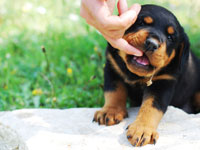Puppy Nipping Behavior

Is your puppy nipping your hands, clothes, or feet all the time? It's normal behavior among dogs, but it's not acceptable for them to do it with people, so they have to be taught.
Nip Nipping and Play Biting in the Bud
While it is perfectly understandable that dogs play bite and are mouthy, it is not allowable for them to do so under most circumstances.
We need to remember that dogs do not have hands with thumbs to explore and feel their world as we do, so they are limited to the use of their mouths for these purposes. As puppies grow, they move, feel, taste, touch, smell, pick up, and drop virtually everything that they can get their mouths on or around, including their littermates, in order to learn about their domain. As they do this, they are taught by their mother and littermates what is acceptable mouthing and what is not.
If a puppy mouths a littermate too aggressively or too hard, the littermate will squeal loudly and often stop playing or interacting with the offending pup, thus punishing him by isolation. After a short period, play resumes. In this way, the puppy learns what is an acceptable level of intensity of mouthing or play-biting and what is not. Mother will also punish the puppy for overly aggressive mouthing of her teats while suckling and/or playing and reward him by continuing to allow him to eat or play when he does so appropriately.
Translating Canine Corrections to Human Ones
When a dog grows up and begins to live in our human world, these lessons must be reinforced by us. Humans should not be mouthed or nipped anywhere on their bodies or on their clothing.
For example, if your puppy or dog should nip your hand or mouth too intensely, one reliable way to curb the behavior is to yell “ouch” or make a loud squealing sound and firmly say a word such as “quit,” “nice,” or “no,” which will cause him to stop and back away. If he does so, he should be praised, then rewarded by being allowed to return to whatever activity you were doing with him before the offensive behavior. This solution often works quickly because the dog is being treated just as he was as a puppy and is familiar with the responses.
If it does not work immediately, the correction level should be raised. If you vocalize and the dog does not quit his behavior, push him away, turn your back to him, do not look at him, and walk away so he understands. After a minute or two, return and begin your interaction again.
Again, if the behavior continues, you may escalate your response to include physically removing the dog from your company and isolating him in a small area for a short time. The bathroom often works well for this. This removal must occur within seconds of the offense and the isolation must not last more than four or five minutes. Dogs live in the present and will quickly lose track of what they are being punished for after a very short amount of time.
It’s possible that these particular methods will not work with some dogs, but there are many other training techniques you may choose from.
Any technique that involves punishments such as hitting and yelling is not only cruel but is also completely ineffective and may only serve to escalate your dog’s behavior to a higher level of intensity. In fact, these types of responses can actually engender aggression and aggressive biting.
If you are having trouble with a nipping dog and have not been able to solve the problem, a visit to your veterinarian, animal behaviorist or dog trainer is highly recommended to ensure your safety and the safety of others.
Remember, nipping or play-biting, especially by an adult dog, can be a dangerous thing. Even a play bite can draw blood and any play bite upon a stranger is a BITE in the legal sense, no matter how you look at it.
You May Also Like These Articles:
How to Stop Your Dog from Jumping on People
You Have E-Mail; Your Dog Has P-Mail
Dr. Google: Helpful or Dangerous?
Slug and Snail Bait Poisoning in Dogs
Retractable Dog Leashes: Know the Risks
How to Teach a Dog to Play Dead
Disclaimer: This website is not intended to replace professional consultation, diagnosis, or treatment by a licensed veterinarian. If you require any veterinary related advice, contact your veterinarian promptly. Information at DogHealth.com is exclusively of a general reference nature. Do not disregard veterinary advice or delay treatment as a result of accessing information at this site. Just Answer is an external service not affiliated with DogHealth.com.
Notice: Ask-a-Vet is an affiliated service for those who wish to speak with a veterinary professional about their pet's specific condition. Initially, a bot will ask questions to determine the general nature of your concern. Then, you will be transferred to a human. There is a charge for the service if you choose to connect to a veterinarian. Ask-a-Vet is not manned by the staff or owners of DogHealth.com, and the advice given should not delay or replace a visit to your veterinarian.



